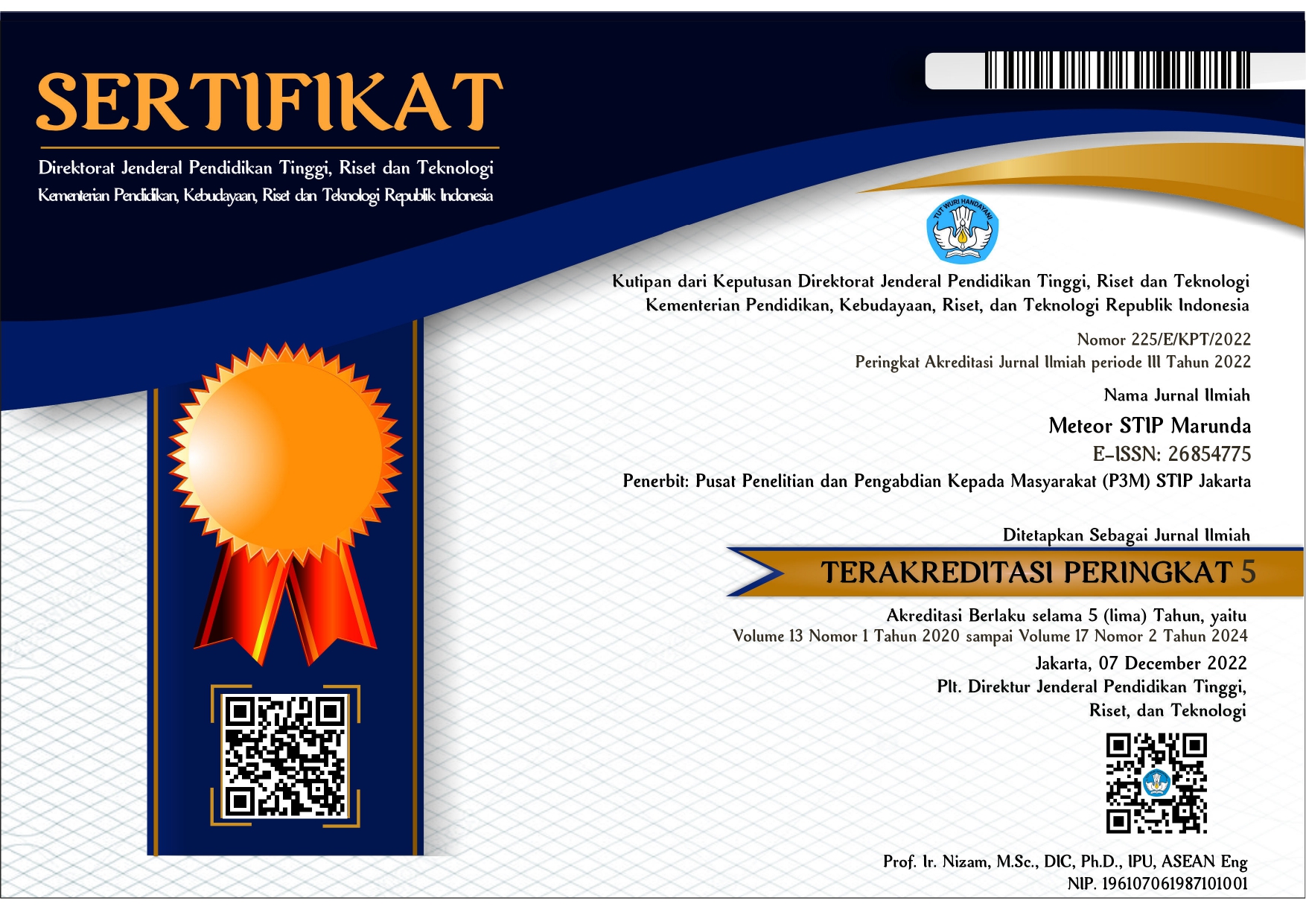ANALYSIS OF THE UTILIZATION OF THE HARBOR AREA AT THE PORT OF TANJUNG PERAK
Abstract
Tanjung Perak Port is the initial gateway to Surabaya which handles more than 40% of international goods trade. In this case, the Kertosusilo Gate Area (GKS) has a very important position with its sea area having the busiest shipping lanes in Indonesia with 15,409 vessels operating at the end of 2021. The dense distribution of port activities in sea transportation creates complex problems which impact on delays in cargo delivery in Tanjung Perak Harbor. Problems that arise include sedimentation due to the construction of the Maspion Indonesia Port terminal, narrowing of sea water and changes in sea area which causes narrowing of the Madura Strait sea area, as well as complaints from port users regarding shipping lanes, anchoring areas in terms of depth, area, Vessel Traffic Services (VTS), services. ship guidance and security. Based on these problems, research was carried out on the utilization and needs of the anchorage area at Tanjung Perak Port. Starting with conducting research preparation, collecting data by compiling data related to the general picture of economic growth, especially in the East Java region as well as operational technicalities and conditions of the Tanjung Perak port. So that we can obtain the results of utilization research for a docking area capacity of 20,330 ships per year with a utility value of the docking area at Tanjung Perak Port of 73.5%.
References
E. P. Merdekawati, A. Mallawa, and F. Amir, Analysis Of Utilization Level Of Main Facilities In Lonrae Fish Landing, Bone District, South Sulawesi, vol. 6.
Kurniawan, R. A. Pradana, and J. A. R. Hakim (2016). Pemodelan Aliran Material Sedimen Akibat Arus Pasang Surut Untuk Pemeliharaan Kedalaman Perairan Pelabuhan, vol. 12, no. 01.
Alonzo Quinn (1972). Design and Construction of Port and Marine Structures. 91.
D. Ariyanto (2018). Evaluasi Pengembangan Pelabuhan Sibolga, Jurnal Penelitian Transportasi Laut, vol. 19, no. 1, pp. 1–13, Jul, doi: 10.25104/transla.v19i1.320.
Director General of Sea Transportation. (2017). Guidelines for Calculating Port Operational Service Performance.
Directorate General of Marine Spatial Management (2018). Ministry of Maritime Affairs and Fisheries, East Java Province Regional Regulation Number 1 of 2018 concerning Zoning Plans for Coastal Areas and Small Islands of East Java Province for 2018-2038.
E. Aprianti and Y. Krisnafi (2020). The Impact Of Minister Of Marine Affairs And
Fisheries Regulation Number 74 Of 2016 On Import Of Fishery Roducts (Case Study: Port of, Jurnal Kebijakan Perikanan Indonesia.
Government, P. (2021). Government Regulation Number 28 of 2021 concerning the Implementation of the Industrial Sector. Government of the Republic of Indonesia.
J. Zain and R. M. Hutauruk. Facilities Utilization In Lampulo Fisheries Port, District Of Kuta Alam, Banda Aceh City, Province Nanggroe Aceh Darussalam.
M. F. Syarifuddin, M. Al Musadieq, and E. Yulianto. Pentingnya Pelabuhan Tanjung Perak Bagi Perekonomian Jawa Timur (Studi pada PT. PELINDO III Tanjung Perak Surabaya).
M. Ilham, R. Thaib (2016). Feasibility of Lampulo Beach Fishing Harbor Pool Size for the Next 10 Years. Marine Science and Fisheries.
Mardi Wibowo and Widjo Kongko (2023). Study Of Dike Effects To Control Sedimentation Process On Patimban’s Port Plan Using Computation Modeling, Majalah Ilmiah Pengkajian Industri, vol. 12, no. 2, pp. 85–96, Sep, doi: 10.29122/mipi.v12i2.2567.
Ministry of Transportation of the Republic of Indonesia (2017). Technical Instructions for Preparing Work Area Boundaries (DLKr) and Port Interest Areas (DLKp).
N. L. P. Hariastuti (2013). Peningkatan Kualitas Layanan Kepada Pelanggan Di Terminal Penumpang Pelabuhan Tanjung Perak Surabaya, Jurnal Ilmiah Teknik Industri, vol. 12, no. 2.
P. Katias and I. K. Muhammad (2017). Analisis Kinerja Berth Time Kapal Kargo Muatan Curah Kering dan Usulan Perbaikannya di Terminal Jamrud Pelabuhan Tanjung Perak Surabaya, Business and Finance Journal, vol. 2, no. 2, Nov, doi: 10.33086/bfj.v2i2.475.
PIANC (1997). Approach Channels a Guide Design. International Association of Ports and Harbors.
R. Khabibah, H. T. Sutanto, and Y. P. Astuti. Sistem Antrian Pelayanan Bongkar Muat Kapal Di Terminal Berlian Pelabuhan Tanjung Perak Surabaya.
S. A. Prasetyo, A. Wicaksono, M. R. Anwar, J. M. T. H. No, and J. Timur (2014). Evaluasi Sistem Logistik Di Pelabuhan Tanjung Perak Surabaya,Jurnal Rekayasa Sipil, vol. 8.
Teknik: Jurnal Ilmiah Ilmu-Ilmu Teknik, vol. 3, no. 2, p. 197, Sep. 2018, doi: 10.51557/pt_jiit.v3i2.183.
U. Kalsum. Analysis Of Port Performance And Parigi Class Iii Port Stacking Field Requirements.
Y. Andrianto, A. Wicaksono, and M. R. Anwar (2017). Analisis Kinerja Pelayanan Pemanduan Kapal Terhadap Waktu Tunggu (Waiting Time) Di Pelabuhan Tanjung Perak, IPTEK Journal of Proceedings Series, vol. 3, no. 5, Nov, doi: 10.12962/j23546026.y2017i5.3114.












_(1)(1).png)

